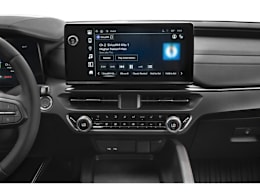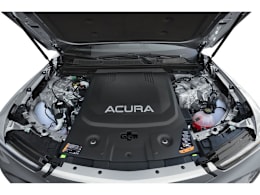Like its Honda Prologue sibling, the ZDX is born of a partnership with General Motors that allows Acura to make use of GM’s Ultium batteries and EV architecture. We found the ZDX to be quick, quiet, and roomy, while also having a relatively long driving range and competitively-quick charging.
It’s a better vehicle than the similar Chevrolet Blazer EV and Prologue, thanks to its smoother ride and more comfortable front seats. But for those who appreciate Acura’s history of taking a sportier approach to luxury, the ZDX doesn’t exude any “Acura-ness.” It feels heavy and isn’t particularly exciting to drive. Despite having 490 horsepower on tap, it’s also rather slow off the line.
The interior isn’t up to the standards of other Acura vehicles, nor does it feel special enough to justify a $70,000 price tag. The mechanically similar Cadillac Lyriq, on the other hand, costs about the same, has a nicer interior, and includes three years of GM’s excellent Super Cruise hands-free active driving assistance system. That feature, which Acura has renamed “Hands Free Cruise,” is available only on the top ZDX Type S trim.
There are some definite upsides to the ZDX, though. After an initially sluggish feeling, the prodigious electric powertrain gives the ZDX some zip. Most of our drivers were big fans of the front seats and, like the Prologue, the ZDX’s infotainment system is much easier to use than in the GM vehicles, plus it comes with wireless Android Auto and Apple CarPlay capability.
“If the ZDX was about $10,000 less it would be more appealing,” said one of our testers. “But it’s hard to justify it when less expensive EVs handle better, have a more premium cabin, and come standard with features like lane centering assistance.”
The ZDX is built in Spring Hill, Tenn., at a GM factory, where it’s assembled alongside the Lyriq. The Prologue and Blazer EV are manufactured in Mexico.
We bought a 2024 Acura ZDX AWD A-Spec for $70,450—anonymously from an area dealer, as we do with every vehicle we test—for the purpose of this road test review.
Driving experience
Even with 490 hp, the ZDX’s power seems modest when you first step on the accelerator pedal. But its smooth, nearly-silent speed builds rapidly as you press down further on the pedal. By the numbers, the ZDX only needed 5.7 seconds to sprint from 0 to 60 mph. While that’s quick compared to most vehicles on the road, it’s notably about a half-second slower than the similar Cadillac Lyriq, as well as the Genesis GV60 and Lexus RZ.
We learned to appreciate the smoothness of the powertrain, though, along with how easy it is to use the car’s “one-pedal driving” mode, which enables you to accelerate and brake by using just the accelerator pedal. Unfortunately, the ZDX doesn’t have as many regenerative-braking levels as some EVs, nor is it as easy to switch between them like in the Genesis GV60 or Electrified GV70, for example.
The ZDX AWD managed a commendable 313 miles during our 70-mph highway-range test. That means the ZDX can go for days without charging. Plus, it doesn’t take as long as you might think to charge its large, 102-kilowatt-hour battery thanks to an 11.5-kW onboard charger which enables the ZDX to take in about 30 miles of range per hour of charging on a Level 2 (240-volt) home system. Meanwhile, its 190-kW maximum acceptance rate at public DC fast-charging stations makes for relatively speedy replenishment on road trips. Unfortunately, the charge port isn’t tied into the central locking system, so anyone can unplug the ZDX at public charging stations.
Although the suspension is firm, it absorbs bumps effectively and sails steadily and serenely down the highway. We found that the ZDX rode more comfortably than the Prologue, a result of different tires and suspension tuning, along with nearly 600 pounds of extra weight over its Honda twin (mostly due to the larger battery). As such, it should come as no surprise that the ZDX feels heavy, but a big part of the SUV’s lack of agility comes from its slow and vague steering. This makes it reluctant to turn into corners, which is unlike most Acura models. It wasn’t a joy to drive at its limits, but it did prove safe and forgiving around our track, although its weight and width resulted in a mediocre performance through our avoidance-maneuver test.
Panic-brake distances were competitive with similar EVs, only requiring 132 feet to come to a stop from 60 mph on our dry surface. Brake-pedal feel is also a ZDX strong suit—they feel powerful but also pretty normal, without being touchy or grabby at low speeds, or suffering from a non-linearity like we’ve seen with many EVs due to the regenerative-braking system.
Cabin comfort
The ZDX’s fit and finish is a letdown compared to most Acura models, and unimpressive when you consider its $70,000-plus as-tested price. While there is some padded leather and chrome trim here and there, the interior has much of the same hard plastic as the Prologue and Blazer EV. Plus, the GM-sourced steering-wheel stalks and switchgear don’t match the quality found in other Acura vehicles.
The cabin is roomy, and most of our drivers found the ZDX’s front seats to be more comfortable and supportive than the Prologue’s, and we appreciate the four-way lumbar adjustment. Both the seatback and bottom cushion have more pronounced contouring, which helps hold you in place through corners, and the padding feels softer.
The driving position is well-sorted for the most part, with abundant headroom, a wide left footrest, and a clear view of the gauges through the steering wheel. Some drivers noted that the hard-plastic center console tends to intrude on right-knee space. Thick windshield pillars create front blind spots, and the rather chopped windows most of the way around the vehicle make for less of an airy experience than in most SUVs.
The rear seat has good space, with decent knee- and foot room, but under-leg support is limited because the bottom cushion is positioned low to the floor. The seat is also quite flat, and the child-seat anchors at the base of the seatback protrude enough to further compromise comfort for some passengers. Headroom will also be a bit tight for taller folks.
The cargo area’s fairly large rectangular shape and flush floor make loading and unloading items pretty easy, and it has slightly more maximum capacity than some of its direct EV competitors.
Controls and usability
Many of the ZDX’s controls, including the column-mounted gear-selector lever and windshield-wiper stalks, are ripped straight from GM’s parts bin. They take some getting used to, and returning Acura customers may instinctively hit the right stalk to use the wipers, only to discover that they bumped the car into Neutral. We also don’t like that the emergency flashers button is hidden high up on the overhead console near the SOS and OnStar buttons—not only is the button small, but its location makes it difficult to find quickly in an emergency situation.
At least the ZDX’s infotainment system is easier to use than in the GM vehicles. The design and graphics are bright and clear, aided by the smaller, more conventional screen. We appreciate that Acura uses grippy knobs and physical buttons for the climate system, instead of putting some—or all—into the infotainment touchscreen. This makes it easier to adjust the system without delay or distraction. We also applaud that the ZDX has wireless Android Auto and Apple CarPlay capability.
Active safety & driver assistance
Standard active safety and driver assistance features include automatic emergency braking with pedestrian detection, automatic emergency braking that operates at highway speeds, blind spot warning, rear cross traffic warning, reverse automatic emergency braking, lane centering assistance, lane departure warning, lane keeping assistance, adaptive cruise control, and automatic high beams.
Only the top ZDX Type S trims come standard with “Hands Free Cruise,” which is a rebranding of GM’s excellent Super Cruise active driving assistance system. It’s not available on the lower trims.
A rear occupant alert system comes standard. It’s designed to remind the driver—based on rear-door logic—to check the rear seat when they turn the ZDX off to help prevent children and pets from suffering heatstroke or hypothermia if unintentionally left behind in the vehicle. The ZDX also has a standard rear belt minder, which alerts the driver if a rear passenger unbuckles their seat belt during the trip.


























